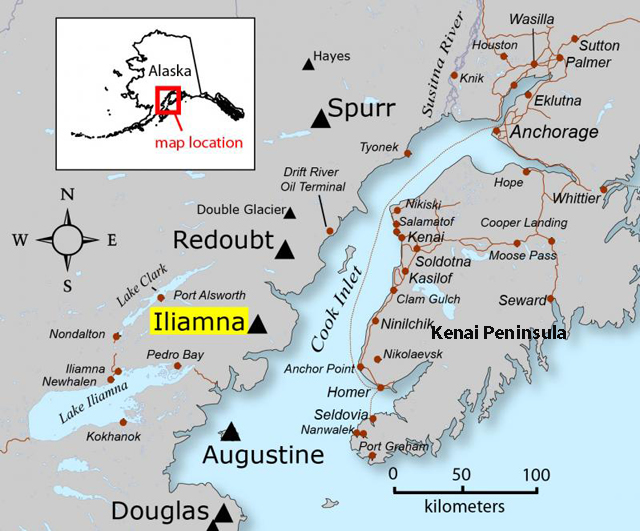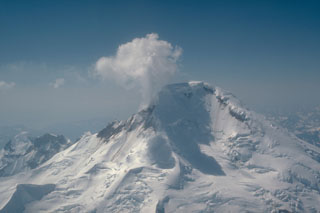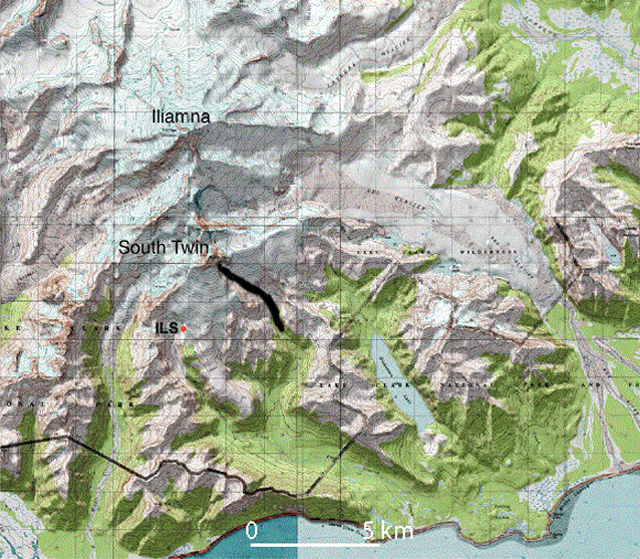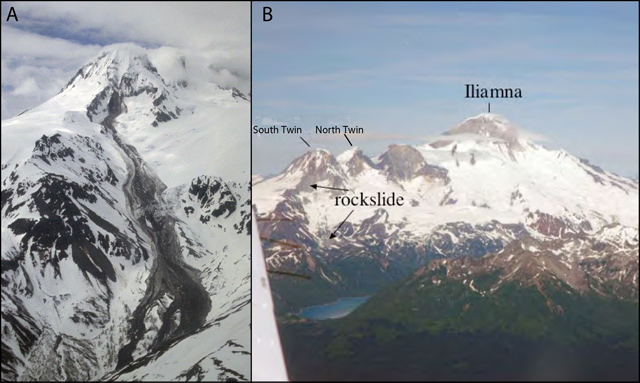Report on Iliamna (United States) — April 2012
Bulletin of the Global Volcanism Network, vol. 37, no. 4 (April 2012)
Managing Editor: Richard Wunderman.
Iliamna (United States) Rockfalls and fumarolic activity continue with spike in early 2012
Please cite this report as:
Global Volcanism Program, 2012. Report on Iliamna (United States) (Wunderman, R., ed.). Bulletin of the Global Volcanism Network, 37:4. Smithsonian Institution. https://doi.org/10.5479/si.GVP.BGVN201204-313020
Iliamna
United States
60.032°N, 153.09°W; summit elev. 3053 m
All times are local (unless otherwise noted)
Iliamna was last discussed in September 1997 (BGVN 22:09). This report is largely based on seismic data extracted from Alaska Volcano Observatory (AVO) yearly reports for 1997 to 2011, with the exception of an increase of seismicity during early 2012 that was reported by various sources. From the start of 2012, both rockfalls and seismicity progressively increased; this prompted AVO to increase the Alert Level to Advisory in March 2012. A map showing the location of Iliamna in relation to nearby volcanoes and communities is depicted in figure 1. Figures 2 and 3 are topographic maps showing Iliamna's known debris avalanches and rockfall deposits.
 |
Figure 1. Map of Iliamna and nearby volcanoes and communities. Iliamna is in SW Alaska near the mouth of the Cook Inlet, and W of the Kenai Peninsula. Courtesy of AVO. |
Most of the upper edifice exposes highly altered, unstable rock and shows scars from mass wasting. The E scar has been the source of frequent non-volcanic gravitational collapses producing mixed avalanches of ice, snow, rock, and mud that typically extend several kilometers downslope. Some are large enough to be visible from the Kenai Peninsula (Neal and others, 1995; McGimsey and Wallace, 1999).
Reports on Iliamna's seismicity since early 1997 are sparse. According to AVO, a pilot reported a fresh deposit of mud and rock on the upper NE flank on 6 July 1999. However, spring and summer avalanches are common on the glacier-dominated summit.
On 25 July 2003, an avalanche of snow, ice, and rock occurred. The event lasted four minutes and was recorded by seismometers located 75 km away on Augustine volcano. The avalanche presumably originated from the same vicinity as in previous years, a steep portion of the SE flank adjacent to an extensive permanent fumarolic zone above a debris-avalanche deposit (figure 3; Neal and others, 1995; McGimsey and Wallace, 1999; McGimsey and others, 2004).
On 15 May 2005, AVO seismologists noted a swarm of unusual seismic activity at Iliamna. The events were emergent and prolonged (the longest lasted 5-8 minutes) and were strongest at seismic station ILS, located on the S flank of South Twin (figure 4). The activity began at about 1250 UTC and tapered off at 1718 UTC. Analysis revealed that the signals most likely were caused by a surficial process, such as a snow avalanche (a common occurrence on Iliamna), but this particular event lacked the usual precursory seismicity preceding other Iliamna snow and ice avalanches ( Caplan-Auerbach and others, 2004; J. Caplan-Auerbach, written commun., 2005; Caplan-Auerbach and Huggel, 2007).
During an overflight on 16 May 2005, Lee Fink of Lake Clark National Park observed a large, fresh rock slide (not a snow or ice avalanche) SE of Iliamna that began at ~1,980 m elevation on the SE flank of South Twin, and ran down to ~365 m elevation (figure 5a). Along the lengthy ridge extending S of Iliamna (including both South Twin, North Twin, and a large unnamed massif) are steep, exposed sections of bedrock. The 15 May rockfall occurred below the ridge (figure 5b).
During Iliamna's mid-May 2005 rock slide, earthquakes at Augustine volcano, ~100 km SSW of Iliamna in the Cook Inlet, increased from 2 per day in April to 70 per day by the end of the year (McGimsey, 2008). However, no evidence exists that this increase disturbed Iliamna. Other factors such as temperature changes, ice and snow mass (and other conditions) would have contributed to the weakening of the summit material at Iliamna.
According to AVO, earthquake numbers increased significantly between 2008-2009, but returned to near-normal levels in 2010 (table 1).
Table 1. Numbers and types of earthquakes at Iliamna between 2008 and 2010. Key: VT, volcanic tremor; LF, low frequency; Mc, magnitude of completion (lowest magnitude detectable); and '--', not reported. Courtesy of AVO.
| Year | Total Earthquakes | Volcanic Tremor | Low-frequency | Other | Magnitude of completion (lowest magnitude detectable) |
| 2008 | 102 | -- | -- | -- | -- |
| 2009 | 173 | 159 | 13 | 1 | 0.3 |
| 2010 | 76 | 61 | 15 | 0 | 0.2 |
Early 2012 elevated seismicity. AVO reported that during December 2011-February 2012, earthquake activity steadily increased. During the first week of March 2012, numerous earthquakes occurred that varied in number and magnitude. According to a press account (Alaskan Dispatch), on 8 March, a moderate M 4.1 earthquake struck the region. On 9 March, AVO increased the Alert Level to Advisory and the Aviation Color Code to Yellow. AVO reported that the increased activity was a significant change, but also noted that a similarly energetic episode of seismic unrest from September 1996 to February 1997 did not lead to an eruption.
Between 9 March through at least 3 April 2012, seismicity remained above background levels. Satellite images acquired during 9-16 March showed a plume drifting 56 km downwind that was likely water vapor. An AVO report noted that long-lived fumaroles at the summit of Iliamna frequently produced visible plumes, but the current plume appeared to be more robust than usual. Scientists aboard an overflight on 17 March observed vigorous and plentiful fumaroles at the summit, consistent with elevated gas emissions. Gas measurements indicated that the volcano was emitting elevated levels of SO2 and CO2, consistent with a magmatic source. During the overflight, scientists did not observe obvious signs of recent rockfalls, such as large areas of newly exposed bedrock or unusual disturbance of the glacial ice. Some deformation of the ice at the headwall of the Red Glacier on the E side of the summit was observed, but it is not clear that this was related to the current volcanic unrest; glacier avalanching is common on this very steep area and was last seen in 2008. During 25-27 March, activity declined somewhat to just above background levels. When not obscured by clouds, satellite and web camera views showed nothing unusual.
References. Caplan-Auerbach, J., Prejean, S.G., and Power, J.A., 2004, Seismic recordings of ice and debris avalanches of Iliamna Volcano (Alaska): Acta Vulcanologica, v. 16, n. 1-2, p. 9-20.
Caplan-Auerbach, J., and Huggel, C., 2007, Precursory seismicity associated with frequent, large ice avalanches on Iliamna volcano, Alaska, USA: Journal of Glaciology, v. 53, n. 180, p. 128-140.
Detterman, R.L., and Hartsock, J.K., 1966, Geology of the Iniskin-Tuxedni region, Alaska: U.S. Geological Survey Professional Paper 512, 78 p.
Dixon, J.P., and Stihler, S.D., 2009, Catalog of earthquake hypocenters at Alaskan volcanoes: January 1 through December 31, 2008: U.S. Geological Survey Data Series 467, 88 p. Available at http://pubs.usgs.gov/ds/467/
Dixon, J.P., Stihler, S.D., Power, J.A., and Searcy, C.K., 2010, Catalog of earthquake hypocenters at Alaskan volcanoes: January 1 through December 31, 2009: U.S. Geological Survey Data Series 531, 84 p. Available online at http://pubs.usgs.gov/ds/531/
McGimsey, R.G., and Wallace, K.L., 1999, 1997 volcanic activity in Alaska and Kamchatka: Summary of events and response of the Alaska Volcano Observatory: U.S. Geological Survey Open-File Report OF 99-0448, 42 p.
McGimsey, R.G., Neal, C.A., and Girina, O., 2004, 1999 Volcanic activity in Alaska and Kamchatka: Summary of events and response of the Alaska Volcano Observatory: U.S. Geological Survey Open-File Report OF 2004-1033, 49 p.
McGimsey, R.G., Neal, C.A., Dixon, J.P., and Ushakov, S., 2008, 2005 Volcanic activity in Alaska, Kamchatka, and the Kurile Islands: Summary of events and response of the Alaska Volcano Observatory: U.S. Geological Survey Scientific Investigations Report 2007-5269, 94 p.
Neal, C.A., Doukas, M.P., and McGimsey, R.G., 1995, 1994 volcanic activity in Alaska-Summary of events and response of Alaska Volcano Observatory: U.S. Geological Survey Open-File Report OF 95-271, 18 p. [Iliamna, p. 4-5].
Waythomas, C.F. and Miller, T.P., 1999, Preliminary Volcano-Hazard Assessment for Iliamna Volcano, U.S. Geological Survey Open-File Report OF 99-373.
Geological Summary. Iliamna is a prominentglacier-covered stratovolcano in Lake Clark National Park on the western side of Cook Inlet, about 225 km SW of Anchorage. Its flat-topped summit is flanked on the south, along a 5-km-long ridge, by the prominent North and South Twin Peaks, satellitic lava dome complexes. The Johnson Glacier dome complex lies on the NE flank. Steep headwalls on the S and E flanks expose an inaccessible cross-section of the volcano. Major glaciers radiate from the summit, and valleys below the summit contain debris-avalanche and lahar deposits. Only a few major Holocene explosive eruptions have occurred from the deeply dissected volcano, which lacks a distinct crater. Most of the reports of historical eruptions may represent plumes from vigorous fumaroles E and SE of the summit, which are often mistaken for eruption columns (Miller et al., 1998). Eruptions producing pyroclastic flows have been dated at as recent as about 300 and 140 years ago, and elevated seismicity accompanying dike emplacement beneath the volcano was recorded in 1996.
Information Contacts: Alaska Volcano Observatory (AVO), a cooperative program of a) U.S. Geological Survey, 4200 University Drive, Anchorage, AK 99508-4667 USA (URL: http://www.avo.alaska.edu/), b) Geophysical Institute, University of Alaska, PO Box 757320, Fairbanks, AK 99775-7320, USA, and c) Alaska Division of Geological & Geophysical Surveys, 794 University Ave., Suite 200, Fairbanks, AK 99709, USA (URL: http://www.dggs.alaska.gov/); Alaskan Dispatch (URL: http://www.alaskadispatch.com/).





